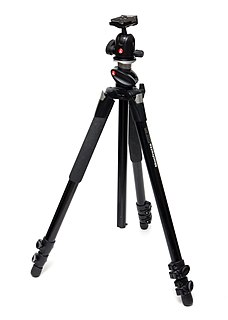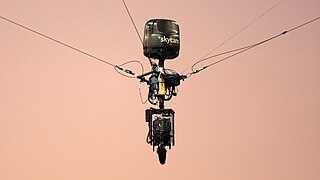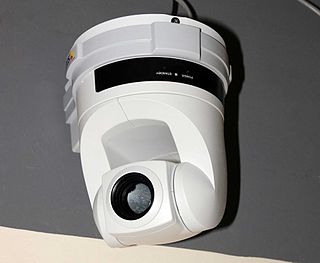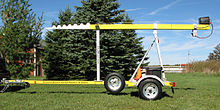
Astrophotography, also known as astronomical imaging, is the photography or imaging of astronomical objects, celestial events, or areas of the night sky. The first photograph of an astronomical object was taken in 1840, but it was not until the late 19th century that advances in technology allowed for detailed stellar photography. Besides being able to record the details of extended objects such as the Moon, Sun, and planets, modern astrophotography has the ability to image objects invisible to the human eye such as dim stars, nebulae, and galaxies. This is done by long time exposure since both film and digital cameras can accumulate and sum photons over these long periods of time.

Steadicam is a brand of camera stabilizer mounts for motion picture cameras invented by Garrett Brown and introduced in 1975 by Cinema Products Corporation. It mechanically isolates the camera from the operator's movement, allowing for a smooth shot, even when the operator moves over an irregular surface.

Telerobotics is the area of robotics concerned with the control of semi-autonomous robots from a distance, chiefly using television, wireless networks or tethered connections. It is a combination of two major subfields, which are teleoperation and telepresence.

Aerial photography is the taking of photographs from an aircraft or other airborne platforms. When taking motion pictures, it is also known as aerial videography.

A professional video camera is a high-end device for creating electronic moving images. Originally developed for use in television studios or with outside broadcast trucks, they are now also used for music videos, direct-to-video movies, corporate and educational videos, wedding videos, among other uses. Since the 2000s, most professional video cameras are digital professional video cameras.

An equatorial mount is a mount for instruments that compensates for Earth's rotation by having one rotational axis, the polar axis, parallel to the Earth's axis of rotation. This type of mount is used for astronomical telescopes and cameras. The advantage of an equatorial mount lies in its ability to allow the instrument attached to it to stay fixed on any celestial object with diurnal motion by driving one axis at a constant speed. Such an arrangement is called a sidereal or clock drive. Equatorial mounts achieve this by aligning their rotational axis with the Earth, a process known as "polar alignment".

Aerial survey is a method of collecting geomatics or other imagery by using airplanes, helicopters, UAVs, balloons or other aerial methods. Typical types of data collected include aerial photography, Lidar, remote sensing and also geophysical data (such as aeromagnetic surveys and gravity. It can also refer to the chart or map made by analysing a region from the air. Aerial survey should be distinguished from satellite imagery technologies because of its better resolution, quality and atmospheric conditions. Today, aerial survey is sometimes recognized as a synonym for aerophotogrammetry, part of photogrammetry where the camera is placed in the air. Measurements on aerial images are provided by photogrammetric technologies and methods.

In photography, a tripod is a portable device used to support, stabilize and elevate a camera, a flash unit, or other videographic or observational/measuring equipment. All photographic tripods have three legs and a mounting head to couple with a camera. The mounting head usually includes a thumbscrew that mates to a female-threaded receptacle on the camera, as well as a mechanism to be able to rotate and tilt the camera when it is mounted on the tripod. Tripod legs are usually made to telescope, in order to save space when not in use. Tripods are usually made from aluminum, carbon fiber, steel, wood or plastic.

Aviation photography is the act of taking images of aircraft, either in flight, or on the ground. Types of aviation photography include air-to-air, ground-to-air, ground-static, and remote photography. Military aviation photography, especially air-to-air, requires additional skills, as the photo and target aircraft often fly at velocities of over Mach 1, while under moderate to high G.

Skycam is a computer-controlled, stabilized, cable-suspended camera system. The system is maneuvered through three dimensions in the open space over a playing area of a stadium or arena by computer-controlled cable-drive system. It is responsible for bringing video game–like camera angles to television sports coverage. The camera package weighs less than 14 kilograms (31 lb) and can travel at 13 m/s (29 mph).

Image stabilization (IS) is a family of techniques that reduce blurring associated with the motion of a camera or other imaging device during exposure.

Tilt–shift photography is the use of camera movements that change the orientation or position of the lens with respect to the film or image sensor on cameras.

The Helicam is a remote-controlled mini helicopter used to obtain aerial pictures or motion images using video, still or motion film cameras. The remote controlled camera mount system allows pan, tilt and roll movements. A wireless onboard video transmitter downlinks the live signal to the camera operator, images can be recorded on board, on the ground or both. The system is controlled by two operators with independent controls: the helicam pilot and camera operator.

First-person view (FPV), also known as remote-person view (RPV), or simply video piloting, is a method used to control a radio-controlled vehicle from the driver or pilot's view point. Most commonly it is used to pilot a radio-controlled aircraft or other type of unmanned aerial vehicle (UAV). The vehicle is either driven or piloted remotely from a first-person perspective via an onboard camera, fed wirelessly to video FPV goggles or a video monitor. More sophisticated setups include a pan-and-tilt gimbaled camera controlled by a gyroscope sensor in the pilot's goggles and with dual onboard cameras, enabling a true stereoscopic view.

A pan–tilt–zoom camera is a camera that is capable of remote directional and zoom control.

The MineCam is a remote exploration camera built by I.A.Recordings. It is used for mine shaft exploration and other similar environments. It was originally conceptualized in 1988, and since went under several design revisions. The name MineCam, is a pun on MiniCam, an early hand-held broadcast camera built by CBS Laboratories.

Aeryon Scout is a small reconnaissance unmanned aerial vehicle (UAV) that was designed and built by Aeryon Labs of Waterloo, Ontario, Canada. The vehicle was developed between 2007 and 2009 and produced from 2009-2015. Production has been completed and it is no longer advertised for sale on the company website.

A tripod head is the part of a tripod system that attaches the supported device to the tripod legs, and allows the orientation of the device to be manipulated or locked down. Modular or stand-alone tripod heads can be used on a wide range of tripods, allowing the user to choose which type of head best suits their needs. Integrated heads are built directly onto the tripod legs, reducing the cost of the tripod system.

The Phantom is a series of unmanned aerial vehicles (UAVs) developed by Chinese technology company DJI.
In cinematography, remote heads, also known as 'hot' heads, or robos are motorized mechanical and/or electronic devices that are used as a mount for film, video or digital cinema cameras and can be controlled from a distance. In most cases this refers to control not only of the physical orientation of the camera body, such as pan (horizontal), tilt (vertical), roll, but also control over many or all camera functions – focus, zoom, color balance, gamma correction, camera menus and other related functions.
























